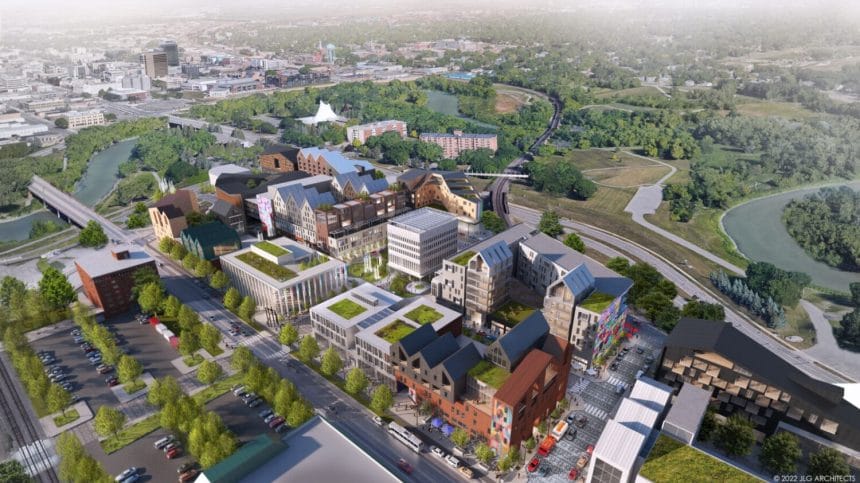Following last November’s successful vote for a half-cent sales tax to finance a new library and community center, the city of Moorhead is set for a dramatic downtown transformation.
We had the opportunity to sit down with Derrick LaPoint, President and CEO of Downtown Moorhead, Inc., Shelly Carlson, Mayor of Moorhead, and Dan Mahli, Moorhead City Manager, to discuss the future of the community. Here is what we learned.
From 2018 to 2021: Laying The Foundations
The initiative traces back to 2018 when Downtown Moorhead, Inc., a nonprofit organization led by its President and CEO Derrick LaPoint, began working with the city to revamp the downtown master plan.
Completed in December 2020, this master plan was part of a larger, city-wide comprehensive plan that laid out an ambitious vision, including transforming the old mall—a consistent public concern.
“During the downtown master process, we had some of the highest public engagement we’ve ever seen,” said LaPoint. The public sentiment was clear—the mall needed to change.
Not only did the Moorhead Center Mall need to change, but what takes its place needs to be a bustling community, according to LaPoint.
“Successful downtowns need to have a neighborhood component,” said LaPoint. “Right now, there just aren’t many housing units around our downtown.”
The Complexity of Many Owners
In order to change that, LaPoint and the others responsible for reshaping Moorhead’s downtown worked to rekindle relationships with developers in the area. But the mall wasn’t an easy target for transformation. Unique in its ownership structure, it was one of the first commercial condos in Minnesota, having multiple owners. This made it challenging to initiate large-scale changes, unlike malls with a single owner.
“In 2019, we entered a pre-development arrangement with Roers to start conversations with the mall tenants and owners,” said LaPoint. This partnership was a significant step towards transforming the area and attracting more development partners, including JLG Architects and Stantec, and accelerating the process for development, which will begin with the demolition of Herberger’s later this fall.
A Vision-Turned Concrete
Working alongside Roers and city staff, JLG Architects and Stantec moved from a conceptual stage to a development scale standpoint. “This has been extremely helpful in just sharing and ultimately getting more development partners on board with what we’re trying to accomplish,” LaPoint said.
Economic Implications
The revitalization efforts aim to change the current site value of about $20 million to an estimated $350 million of reinvestment into the area. This includes significant commercial and housing components.
Challengers Faced By The Downtown Developers
- Public Skepticism: One major hurdle is convincing the citizens that the project is indeed happening. The lack of visible progress fuels doubts, and there’s a strong desire for concrete actions, like demolitions, to reassure the public. These are coming!
- Economic Conditions: Current high interest rates and other economic variables make the timing and financing more complex. Developers are running businesses and need to see a return on their investments, adding another layer of complexity to the timeline of the proposed downtown projects.
- Site Complexity: The large site requires the coordination of multiple development partners and must be carefully planned and phased to align with utilities, infrastructure, and existing structures.
The Science of Walkable Neighborhoods
One of the core concepts behind the new development plan is to create a walkable, mixed-use neighborhood. “The science is that inside a five-minute walk circle if you have 1,000 or more quality housing units, you can support the community and commercial amenities that make a neighborhood thrive,” Mahli said.
Eliminating The Zero-Sum Game
Mayor Carlson also stressed the project’s potential to foster a more collaborative relationship between Moorhead and Fargo, essentially eliminating the zero-sum game that has existed between the two cities. “Our downtowns work together. With the river, we want to amplify the urban vibe between both cities while adding components that are uniquely Moorhead,” she said.
Upcoming Developments
With the demolition of Herberger’s scheduled for later this fall and development beginning on the east side of the mall in spring 2024, significant progress will soon be visible.
The Rotary Natural Play Hill is also under construction to the west of the Moorhead Center Mall.
Commitment To Local Identity
This project isn’t just a generic downtown revamp; it’s a loving tribute to Moorhead’s unique identity. When people walk through the area, they’ll feel the vibrant urban atmosphere without losing the sense of being in Minnesota, thanks to the lush greenery, waters, and natural elements that extend even to the indoor playground.
Sustainable and Radical Density
Moorhead is breaking from the traditional “donut” model of urban development, where downtowns were left vacant in favor of suburban sprawl. Instead, Moorhead is strategically focusing on revitalizing its core. The project aims to tackle 70s-era strip malls, convert them into valuable assets, and go vertical. This will create a ‘radical density’ that will breathe life into the community and generate opportunities for future growth.
As it sits right now, the current site for redevelopment sits at a value of $20 million. However, estimates for reinvestment into the area sit at around $350 million currently.
Community-Driven Amenities
Drawing from extensive community engagement, the redevelopment will feature a myriad of amenities. From an indoor walking track aimed at providing a recreational space particularly in harsh winters, to an entrepreneurship center funded by a $1 million federal grant, it’s clear that the needs and wants of the community are front and center. There will also be a natural playground, coffee spots, and multifunctional community rooms that can adapt to different needs and events.
Flexibility and Adaptability
Furniture, room sizes, and even shelving in the library will be designed for flexibility, meaning spaces can be quickly adapted for various community events or needs. The idea is to make the downtown area not just a place to visit, but a living, evolving entity that serves the community in a myriad of ways.
Long-Lasting Impact
The ripple effect of this project has already begun, stimulating other development projects like boutique hotels and enhancing the broader area. Given its deep community involvement, the project promises to leave a legacy that the community will cherish for generations.
Extended Hours
The project aims to have a community center that remains open longer than traditional library hours, ensuring more people can make use of the facilities, even on days like Sundays.
In essence, the Moorhead downtown redevelopment is not just an urban project but a community-building initiative. It promises to be a space that fuses modern amenities with a strong local identity, making it a model for how communities can redevelop while staying true to their roots.











